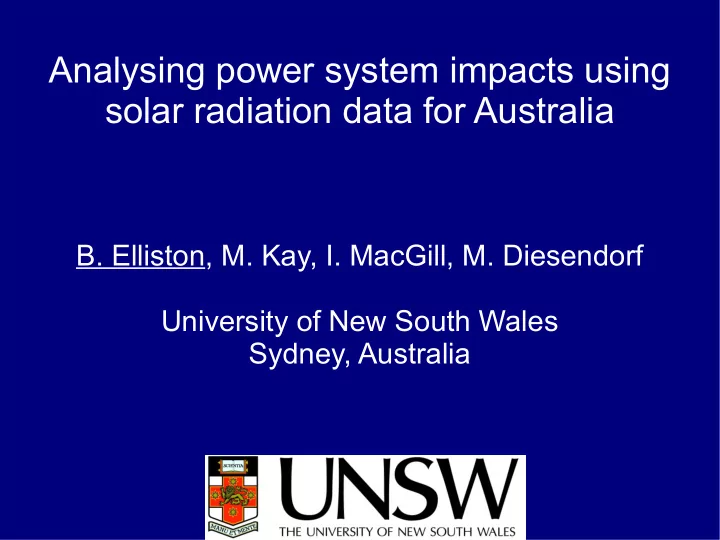

Analysing power system impacts using solar radiation data for Australia B. Elliston, M. Kay, I. MacGill, M. Diesendorf University of New South Wales Sydney, Australia
Why care about extreme events? Source: Illawarra Mercury
Why care about extreme events? 1200 1000 800 600 Power (MW) 400 200 0 Lull in NEM wind power May 17-20, 2010. Data from AEMO.
Outline ● The CST context ● Solar radiation data set ● Computational method ● Results for Australia ● More detailed results for two locations ● Roma (Queensland), Curnamona (SA) ● Conclusions
The CST context Aqua satellite image of dust storm over NSW. Source: Geoscience Australia
The CST context Simulated 100MW trough plant in Cobar, NSW, September 2009
What is useful for CST planning? ● CST w/ 7+ hours storage can ride through short periods of low irradiance ● eg. Gemasolar ● Characterising long low irradiance events ● DNI < 400 W/m 2 ● How long are they? ● When and where do they occur? ● How frequently do they occur?
Historical solar radiation data set ● DNI data from BoM (1998 – 2010) ● Satellite-derived ● 5km x 5km x 1h resolution ● 113,952 x 679 x 839 values ● DNI computed via Ridley/Boland diffuse model ● Some missing data ● PyTables used for analysis
Historical solar radiation data set Satellite image (2am 13 Feb 2000) courtesy of Bureau of Meteorology
Historical solar radiation data set Corresponding hourly grid of estimated DNI values
Computational method ● Needs to be fast ● “Embarrassingly” parallel problem ● Method: ● Initialise 2 working matrices: C , M ● For each hour: – C = ( C + B ) ○ B (increment if b i, j is 1, reset if 0) – M = max ( M , C ) ● Two result matrices: ● Maximum duration, starting hour number
How long are the longest events? 20 18 16 14 Consecutive days 12 10 8 6 4 2 2 0 Longest events typically last 4 to 8 days across Australia
When do the longest events occur? January June/July December Starting month of longest low DNI events
Roma 10 longest events Map courtesy of Google Maps
Roma 10 longest events Start (UTC) End (UTC) Hours Days 2000-02-12 2000-02-18 139 6 2008-01-14 2008-01-20 138 2010-02-27 2010-03-05 136 1998-12-29 1999-01-03 134 2010-09-16 2010-09-21 115 5 1998-04-13 1998-04-17 113 2000-04-22 2000-04-26 113 2000-11-13 2000-11-17 111 2010-01-03 2010-01-07 110 2000-11-07 2000-11-11 109
MSLP map for 15 Feb 2000 Tropical Cyclone Marcia (category 1) in Indian Ocean
Curnamona 10 longest events Map courtesy of Google Maps
Curnamona 10 longest events Start (UTC) End (UTC) Hours Days Start (UTC) End (UTC) Hours 1998-07-31 1998-08-04 89 4 2000-02-12 2000-02-18 139 2007-01-17 2007-01-20 83 1999-03-24 1999-03-27 71 3 2004-05-31 2004-06-30 66 2000-03-18 2000-03-20 65 2006-07-13 2006-07-15 65 2007-03-18 2007-03-21 65 2004-07-22 2004-07-24 64 2005-07-06 2005-07-08 64 2010-02-01 2010-02-03 64
Conclusions ● Some very long low irradiance events ● No CST output for 5+ days ● Storage to ride through clearly uneconomic ● Storage insufficient to provide system security ● North/south diversity useful ● Longest northern events in summer ● Longest southern events in winter ● Diversity comes at a cost: poorer DNI in south
Acknowledgements ● Australian Solar Institute ● Intersect Australia ● NCI National Facility Questions?
Recommend
More recommend